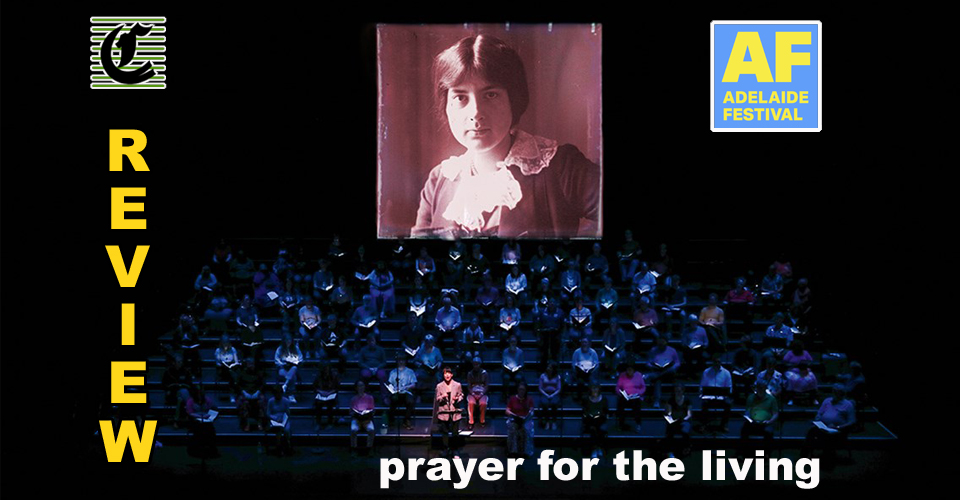[CLASSICAL MUSIC ~ AUSTRALIAN EXCLUSIVE ~ AUS]
Festival Theatre, Sun 20 Mar.
On the closing day of the Adelaide Festival 2022, this joint venture between the Adelaide Symphony Orchestra, the Elder Conservatorium Chorale and the Graduate Singers choirs was a timely entreaty for peace, acceptance and love. The audience was treated to a moving two hours of music combining a large choir of professional and amateur voices, featuring soloist soprano Stacey Alleaume and tenor Nicholas Jones under the guidance of conductor Benjamin Northey and choral director Carl Crossing.
Before the music even begins, the visual staging of this production is arresting. The 90 or so chairs for the choir are placed 1.5 metres apart and ascending in rows to fill the stage, and with a Red Cross banner illuminated behind them, give the impression perhaps of a military burial ground. When the choristers arrive, individual lights above their scores, when seen en masse, appear to symbolise little beacons of hope. Such artistic staging added greatly to the power of the music.
The first half consisted of six pieces, beginning with Latvian composer Peteris Vask’s Prayer For A Mother, which was hauntingly beautiful. Soaring soprano lines and closing with the choir cooing to a baby made this a standout. A screen backdrop showing the haunted and brave faces of mothers and children in times of war and adversity made a great juxtaposition and added layers of meaning to this section of the performance. Closeups of players in the orchestra and the choir also added a special element throughout the performance highlighting the humanity of the pieces being performed and the players themselves.
French composer Lilli Boulanger’s 1913 piece One Buddhist Prayer was another highlight. With the text of the prayer projected onto the screen backdrop the audience was able to immerse themselves into the sentiment of the words whilst succumbing to the beauty of Jones’ moving solo.
The poignant simple melody of Don Nobis Pacem (Give Us Peace), again by Peteris Vask, built into something greater with the addition of the choirs and it was easy to imagine how such a piece would sound in a great cathedral.
The second half was shorter and more uplifting and positive. Francois Poulenc’s Gloria (1960) had a lightness to it and a sense of hope; in some moments it almost took on a sense of fun.
The need for a sense of community, and a longing for peace in our world is vitally needed at the moment both in the Ukraine and other countries ravaged by war, but also in the many communities being devastated by catastrophic weather and states of emergency. Having a large group of musicians and singers come together to sing as one about grief, loss and hope is such a uniting force and today many of the audience would have left feeling that power.
5 stars
Cathy Tune
#ClotheslineMag
#AdelaideFestival

[CLASSICAL MUSIC ~ AUSTRALIAN EXCLUSIVE ~ AUS] Festival Theatre, Sun 20 Mar. On the closing day of the Adelaide Festival 2022, this joint venture between the Adelaide Symphony Orchestra, the Elder Conservatorium Chorale and the Graduate Singers choirs was a timely entreaty for peace, acceptance and love. The audience was treated to a moving two hours of music combining a large choir of professional and amateur voices, featuring soloist soprano Stacey Alleaume and tenor Nicholas Jones under the guidance of conductor Benjamin Northey and choral director Carl Crossing. Before the music even begins, the visual staging of this production is arresting. The 90 or so chairs for the choir are placed 1.5 metres apart and ascending in rows to fill the stage, and with a Red Cross banner illuminated behind them, give the impression perhaps of a military burial ground. When the choristers arrive, individual lights above their scores, when seen en masse, appear to symbolise little beacons of hope. Such artistic staging added greatly to the power of the music. The first half consisted of six pieces, beginning with Latvian composer Peteris Vask’s Prayer For A Mother, which was hauntingly beautiful. Soaring soprano lines and closing with the choir cooing to a baby made this a standout. A screen backdrop showing the haunted and brave faces of mothers and children in times of war and adversity made a great juxtaposition and added layers of meaning to this section of the performance. Closeups of players in the orchestra and the choir also added a special element throughout the performance highlighting the humanity of the pieces being performed and the players themselves. French composer Lilli Boulanger’s 1913 piece One Buddhist Prayer was another highlight. With the text of the prayer projected onto the screen backdrop the audience was able to immerse themselves into the sentiment of the words whilst succumbing to the beauty of Jones’ moving solo. The poignant simple melody of Don Nobis Pacem (Give Us Peace), again by Peteris Vask, built into something greater with the addition of the choirs and it was easy to imagine how such a piece would sound in a great cathedral. The second half was shorter and more uplifting and positive. Francois Poulenc’s Gloria (1960) had a lightness to it and a sense of hope; in some moments it almost took on a sense of fun. The need for a sense of community, and a longing for peace in our world is vitally needed at the moment both in the Ukraine and other countries ravaged by war, but also in the many communities being devastated by catastrophic weather and states of emergency. Having a large group of musicians and singers come together to sing as one about grief, loss and hope is such a uniting force and today many of the audience would have left feeling that power. 5 stars Cathy Tune #ClotheslineMag #AdelaideFestival
Prayer For The Living: Where Voices Of Hope, Music And Sound Collide ~ Adelaide Festival 2022 Review
Prayer For The Living: Where Voices Of Hope, Music And Sound Collide ~ Adelaide Festival 2022 Review
2022-03-21
Cathy Tune
Catherine Tune
100
Conducted by Benjamin Northey, Choral Director Carl Crossin and the Adelaide Symphony Orchestra
User Rating: Be the first one !
100






